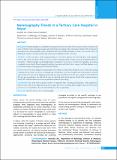Please use this identifier to cite or link to this item:
https://hdl.handle.net/20.500.14356/1477| Title: | Mammography Trends in a Tertiary Care Hospital in Nepal |
| Authors: | Jha, Anamika Chaudhary, Ranjit Kumar |
| Citation: | JhaA., & ChaudharyR. K. (2021). Mammography Trends in a Tertiary Care Hospital in Nepal. Journal of Nepal Health Research Council, 18(4), 667-671. https://doi.org/10.33314/jnhrc.v18i4.2268 |
| Issue Date: | 2020 |
| Publisher: | Nepal Health Research Council |
| Article Type: | Original Article |
| Keywords: | BIRADS Breast Cancer Mammography |
| Series/Report no.: | Oct-Dec, 2020;2268 |
| Abstract: | Abstract Background: Mammography is an established screening tool for early detection of breast cancer, with several protocols used worldwide. Such screening programs and related data are lacking in less developed countries. We documented and analyzed the mammographic trends at Tribhuvan University Teaching Hospital, a tertiary care referral center, in Kathmandu, Nepal, to develop baseline data which may be helpful in further researches. Methods: In this descriptive study, imaging findings of consecutive patients who had undergone mammography between July 2016 and March 2018 were reviewed after obtaining ethical clearance from the Institutional Review Committee. Ultrasonography and histopathological examination were done as needed. Demographics, presenting complaints, breast density, Breast Imaging, Reporting, Assessment and Data System category and final diagnosis were recorded and analyzed using appropriate statistical methods. Results: There were more diagnostic mammograms (62%) than screening with mastalgia the most common presenting complaint. Breast density was less in screening group. Overall, there were more benign lesions with incidence of breast cancer being 4.4% more in the diagnostic group. The age range varied from 22 to 86 years, with 15% (n=219) below 40 years age accounting for one-third of the cases of extremely dense breast and one-fourth of the suspicious lesions. Nearly 50% of breast cancers were seen in patients less than 50 years of age. Conclusions: The study showed greater number of diagnostic than screening mammograms, with malignancies detected more often in the diagnostic group and younger age. Fewer screening studies suggest a lack of breast cancer awareness in our population who seek medical help only when symptomatic. Keywords: BIRADS; Breast Cancer; Mammography |
| Description: | Original Article |
| URI: | http://103.69.126.140:8080/handle/20.500.14356/1477 |
| ISSN: | Print ISSN: 1727-5482; Online ISSN: 1999-6217 |
| Appears in Collections: | Vol. 18 No. 4 (2020): Vol. 18 No. 4 Issue 49 Oct-Dec 2020 |
Files in This Item:
| File | Description | Size | Format | |
|---|---|---|---|---|
| 2268-Manuscript-19997-1-10-20210122.pdf | Fulltext Download | 233.11 kB | Adobe PDF |  View/Open |
Items in DSpace are protected by copyright, with all rights reserved, unless otherwise indicated.
